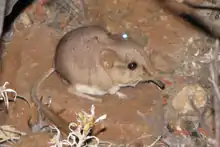Macroscelides micus
Macroscelides micus (common name Etendeka round-eared sengi or Etendeka round-eared elephant shrew) is a species of elephant shrew in the family Macroscelididae. It is only found in gravel plains in the Etendeka formation of north-west Namibia.[2] Measuring about 7.3 inches (19 cm) long and weighing less than an ounce (28 grams), the species is the smallest in the elephant shrew family.[3]
| Macroscelides micus | |
|---|---|
 | |
| Scientific classification | |
| Kingdom: | Animalia |
| Phylum: | Chordata |
| Class: | Mammalia |
| Order: | Macroscelidea |
| Family: | Macroscelididae |
| Genus: | Macroscelides |
| Species: | M. micus |
| Binomial name | |
| Macroscelides micus Dumbacher & Rathbun, 2014 | |
 | |
| ● specimen localities | |
Description
Macroscelides micus is the smallest known elephant shrew. Its body shape resembles that of a long-nosed mouse.[4] However, as a member of the superorder Afrotheria, it is actually more closely related to elephants and manatees than mice.[3] It has pink skin and red fur which helps it camouflage itself against the volcanic rocks of its environment.[3][4] It weighs less than one ounce (28 grams) and is 7.3 inches (19 cm) long, including the tail, when fully grown. M. micus has long, thin legs relative to its body.[4]
M. micus does not burrow, instead sleeping in bushes. It uses its long nose to hunt for ground insects.[4] Some elephant shrew species are known to be monogamous and mate for life.[3] It is unknown if this is the case for M. micus. The young of M. micus, which are often born as twins, are capable of running from birth.[4]
Discovery and identification

Macroscelides micus was first spotted as an unusual sample (collected in 2006) among a collection of elephant shrews stored at the California Academy of Sciences, its red fur distinguishing it from other specimens. Genetic testing suggested it was a distinct species, but additional evidence was needed to confirm the finding. Dumbacher et al. traveled to the Namib Desert nine times over a number of years where they set traps baited with peanut butter, oats, and Marmite. A total of 21 elephant shrew specimens were obtained, 15 of which belonged to the new species.[3]
In 2014, Dumbacher et al. formally described M. micus as a new species. The specific name comes from the Greek mikros, meaning small. The "Etendeka" in the common name is the native word for the mountain range where M. micus lives. The scientific team speculated the species had not previously been identified because it has a small range in a remote area that is hard to reach.[3]
Related species
Macroscelides micus is sympatric with Macroscelides flavicaudatus, but remains physically and genetically distinguishable from it. The study which first identified M. micus did not find evidence of gene flow or interbreeding between the populations. Additionally, the species live in different habitats. M. micus is found among the gravel at the bases of hills and mountains in low-lying areas of the Etendeka geological formation; M. flavicaudatus is found among sedimentary deposits in the Awahab Outliers and river valleys.[2]
M. micus does not overlap Macroscelides proboscideus geographically. A maximum likelihood analysis of four genes by computational phylogenetics indicated that M. proboscideus and M. flavicaudatus are sister species, with M. micus being less closely related.[2]
The authors also explained several limitations and confusions involving an enigmatic report of Macroscelides melanotis (Ogleby 1838), whose type specimen was not available for destructive DNA testing and had an "unnatural" appearance. Recommending M. melanotis be treated as a nomen dubium, they expressed doubt that the described characteristics were consistent with M. micus: "The reported pale, reddish brown chest color is not visible on the specimen, nor is the dunnish white abdomen or throat."[2]
References
- Rathbun, G.B. & Dumbacher, J. (2015). "Macroscelides micus". IUCN Red List of Threatened Species. 2015: e.T45434566A45436004. doi:10.2305/IUCN.UK.2015-2.RLTS.T45434566A45436004.en.
- Dumbacher, J. P.; Rathbun, G. B.; Osborne, T. O.; Griffin, M. & Eiseb, S. J. (2014). "A new species of round-eared sengi (genus Macroscelides) from Namibia". Journal of Mammalogy. 95 (3): 443–454. doi:10.1644/13-MAMM-A-159.
- Khan, Amina (June 27, 2014). "New sengi species is related to an elephant, but small as a mouse". Los Angeles Times. Retrieved June 27, 2014.
- Zuckerman, Laura (June 27, 2014). "In Namibia, a tiny relative of the elephant". Christian Science Monitor. Reuters. Archived from the original on July 1, 2014. Retrieved June 28, 2014.
